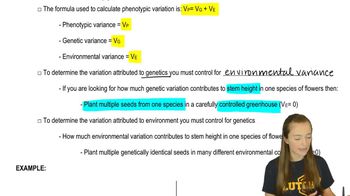All life shares DNA as the hereditary material. From an evolutionary perspective, why do you think this is the case?
Table of contents
- 1. Introduction to Genetics51m
- 2. Mendel's Laws of Inheritance3h 37m
- 3. Extensions to Mendelian Inheritance2h 41m
- 4. Genetic Mapping and Linkage2h 28m
- 5. Genetics of Bacteria and Viruses1h 21m
- 6. Chromosomal Variation1h 48m
- 7. DNA and Chromosome Structure56m
- 8. DNA Replication1h 10m
- 9. Mitosis and Meiosis1h 34m
- 10. Transcription1h 0m
- 11. Translation58m
- 12. Gene Regulation in Prokaryotes1h 19m
- 13. Gene Regulation in Eukaryotes44m
- 14. Genetic Control of Development44m
- 15. Genomes and Genomics1h 50m
- 16. Transposable Elements47m
- 17. Mutation, Repair, and Recombination1h 6m
- 18. Molecular Genetic Tools19m
- 19. Cancer Genetics29m
- 20. Quantitative Genetics1h 26m
- 21. Population Genetics50m
- 22. Evolutionary Genetics29m
1. Introduction to Genetics
History of Genetics
Problem 14f
Textbook Question
Briefly describe the contribution each of the following people made to the development of genetics or genetic analysis.
Edmund B. Wilson
 Verified step by step guidance
Verified step by step guidance1
Edmund B. Wilson was a prominent biologist who made significant contributions to the field of genetics and cytology.
He is best known for his work on the chromosomal theory of inheritance, which proposed that chromosomes are the carriers of genetic material.
Wilson, along with Nettie Stevens, discovered the chromosomal basis of sex determination, identifying the role of the X and Y chromosomes in determining male and female sexes.
He also contributed to the understanding of cell division processes, such as mitosis and meiosis, which are critical for the transmission of genetic information.
Wilson's research laid the groundwork for linking cytology (the study of cells) with Mendelian genetics, helping to establish the modern understanding of heredity.
 Verified video answer for a similar problem:
Verified video answer for a similar problem:This video solution was recommended by our tutors as helpful for the problem above
Video duration:
2mPlay a video:
Was this helpful?
Key Concepts
Here are the essential concepts you must grasp in order to answer the question correctly.
Chromosomal Theory of Inheritance
The Chromosomal Theory of Inheritance posits that genes are located on chromosomes, which are the carriers of genetic information. This theory was pivotal in linking Mendelian genetics to the physical structures within cells, providing a framework for understanding how traits are passed from one generation to the next.
Recommended video:
Guided course

Chromosome Structure
Cytogenetics
Cytogenetics is the branch of genetics that studies the structure and function of chromosomes. It involves the examination of chromosomal abnormalities and their implications for genetic disorders, making it essential for understanding genetic inheritance and variation.
Edmund B. Wilson's Contributions
Edmund B. Wilson was a prominent biologist who contributed significantly to the field of genetics through his work on the Chromosomal Theory of Inheritance. He helped establish the importance of chromosomes in heredity and was instrumental in advancing the understanding of genetic linkage and the behavior of chromosomes during cell division.
Recommended video:
Guided course

Analyzing Trait Variance
Related Videos
Related Practice
Textbook Question
845
views


